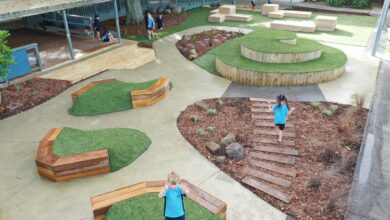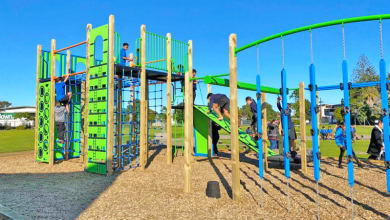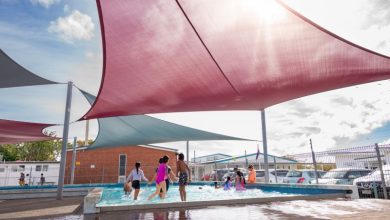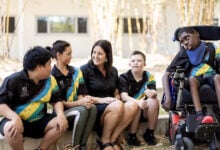Kaipara College – Transformation from adversity
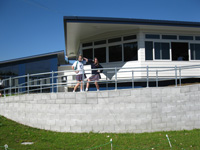
 It is not quite a case of the phoenix rising from the ashes but it is fairly close to it. When a major fire struck Kaipara College back in 2006, it brought major disruption to the school of about 600 pupils in Helensville,
It is not quite a case of the phoenix rising from the ashes but it is fairly close to it. When a major fire struck Kaipara College back in 2006, it brought major disruption to the school of about 600 pupils in Helensville,
on the western outskirts of Auckland. It is the local community school on the edge of the Kaipara Harbour and its pupils are drawn from a very wide area and a diverse community including farmers, lifestyle blockers, small business people and beachside dwellers.
 |
 |
 |
 |
When an accidental fire blazed through part of the school, it caused major disruption to school activities. It burned out three classrooms and a resource area and damaged four other classrooms. Two computer rooms were cut off, meaning the entire ICT infrastructure had to be relocated to the soccer fields.
Fortunately, the buildings destroyed or damaged were all between 55 and 80 years old and in a block that was part of the original district high school which the college had planned to replace anyway.
“The Ministry of Education had turned us down on the first application but then the fire gave us an opportunity to re-present it,” said principal, John Grant. “At the end of 2006 we presented the ministry with a proposal for a staged redevelopment of about two thirds of the school.”
The ministry agreed to fund it in four stages. Three are now complete – the third and largest in 2011. Stage four should start within weeks, removing the old science block and putting a new social sciences faculty in its place.
John Grant says the transformation has been huge. “We redeveloped the gymnasium area and rebuilt the science block. Stage three was a rebuild of lots of the central parts of the school. It includes drama, some music rooms, a staff room, a complete student facility centre, the English faculty and the ICT rooms. The careers and foreign student rooms are all part of the student services area.
“We did it stage by stage because you can’t rebuild a huge chunk of a school without major disruption. Stage three was particularly disruptive because it took out the whole centre part of the school which had to be locked off while we built. The school hall became the staffroom and students and staff all had to walk a long way around to get to where they needed to go.
“There were some very patient students and staff for four years, but it’s been very worthwhile. The facilities are great now. We’ve taken the styles of the district high school, with its weather boards, verandas and courtyards, and translated those into the modern learning environments. They are cabled, with computers and data projectors, all arranged for modern teaching.
“We now have a much better learning environment. The school has a new three quarter sized gymnasium and changing rooms, a new specialist health class, a new sports science classroom and a sports management office. There is a complete new science faculty – five teaching labs, a computer room and a smaller senior chemistry cum physics lab, along with staff resource areas. We have a complete new English faculty, English work room and air conditioned classrooms right through these new blocks.
“Teachers have a brand new staffroom while students have a new mini theatre for their drama room, two new music practice rooms and two new computer (ICT) classrooms. All of these spaces are air conditioned. We have a new student services centre which has space for a social worker, student adviser, attendance manager, health centre, careers, gateway and international student department.
“Five new classrooms and a faculty office for social sciences are still to come. By the end of this year, well over two thirds of the school will have been rebuilt into modern learning environments,” Mr Grant said.
College facilities manager Sue Glasson says while the fire of 2006 was devastating, in the longer term it has had its benefits. “We grieved for what we lost in the fire. Its impact was significant but we were forced to step back and look at the whole school – not just the burnt out part. Priorities had to change to use the site to the best advantage whilst retaining enough classrooms to teach in throughout,” she said.
The principal agrees. “The fire ended up providing the impetus for the school to get a very coherent plan together and for the ministry to address it in that way. We’ve gradually delivered exactly what we visualised.
“Waitakere Architects have been the architect and our project manager right throughout the redevelopment. They were instrumental in helping the board to visualise the possibilities to redevelop the school.”
Three different construction firms have handled the three stages. Sue Glasson has been the schools main contact person to liaise with the contractors and project manager. “Each of them has been really good to work with. They understand working in schools. They provided us with excellent site managers and foremen each time and we’ve got good working relationships with them,” she said.
Watts & Hughes Construction was the main company involved and found it a satisfying project to be involved in. “It was a little challenging due to the number of services, such as power and water, that had been run through the original building that was to be demolished,” said the company’s construction director, Rob Murphy. “We found the school extremely understanding and helpful to work with, which made this project very rewarding for us.”
So, in spite of the inconvenience, John Grant has no doubt that it has all been worthwhile. “We’ve lived on a building site for five years but it’s resulted in a significant improvement in the school’s environment. The rooms are quieter, cooler, larger and generally better places for kids to learn. It’s all a vast improvement on the old 1930s/1960s school that was here five years ago.
“The kids love it. The staff love it, especially in the hot summer months when there are air conditioned classrooms to come into in the latter part of the day. We’ve noticed the kids are a lot more productive in the summer afternoons and late mornings than they were in the old, hot, rooms or prefabs without insulation and with little air movement. “It’s a much better school now and we’re all very happy.”


